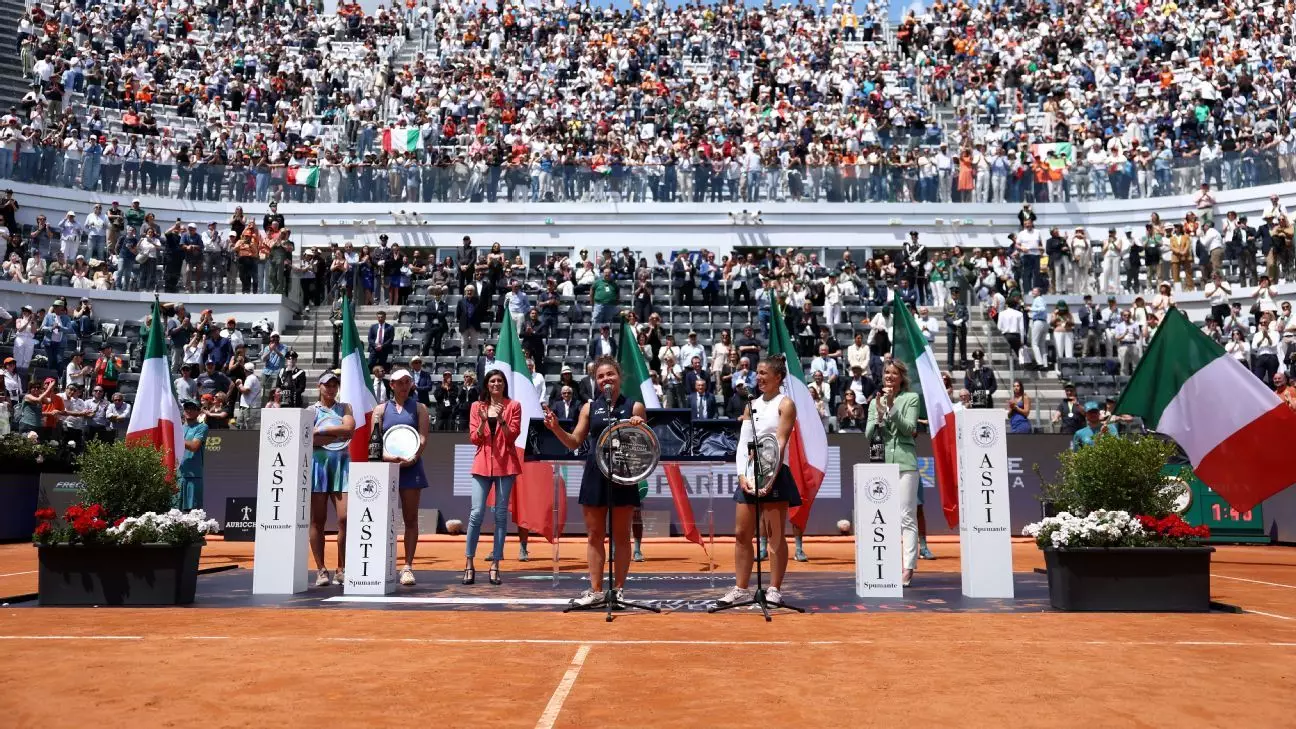In the evolving landscape of international tennis, the spotlight firmly shines on Italy, a nation experiencing a remarkable renaissance in this beloved sport. With Jannik Sinner leading the charge as one of the world’s top players, the Italian presence in tennis has never been stronger. Moreover, the recent triumphs of Jasmine Paolini, who captured the Italian Open after a staggering four-decade wait, highlight the growing prowess of Italian players on both national and global stages. This surge is not merely a fleeting moment; it represents a cultural shift, with a new generation of athletes like Lorenzo Musetti and Federico Cinà emerging as powerful contenders. These players not only signify a brighter future for Italian tennis but also serve as emblematic figures symbolizing the nation’s vigorous passion for sports.
Ambitious Aspirations: A New Era for the Italian Open
At the helm of the Italian Tennis and Padel Federation, President Angelo Binaghi is not content with mere participation in tennis—he aspires for greatness. His ambitious vision includes elevating the Italian Open to join the ranks of the Grand Slam tournaments, a bold move that challenges over a century of tennis tradition. This idea is fuelled not only by Italy’s recent successes but also by a recognition that the current landscape of tennis is in dire need of expansion. “Why should there only be four major tournaments?” Binaghi provocatively queries. He argues that this monopoly stifles growth and diversity within the sport. The Italian Open, currently classified as a Masters Series event, has rapidly blossomed, and with plans for expansion and modernization, it is well-positioned to capitalize on its newfound significance.
Structural Transformations and Capital Investments
Strategic structural changes emphasize the Italian Open’s commitment to evolving into a more prestigious event. Recent announcements regarding the construction of a retractable roof over the iconic Campo Centrale stadium are a bold commitment to enhancing the venue’s capacity and appeal. Slated for completion by the 2028 tournament, this investment exemplifies a forward-thinking approach designed to accommodate the growing demand for high-quality tennis experiences. With an investment of €60 million and the addition of 2,000 seats, these upgrades illustrate Italy’s determination to not only keep pace with the competition but to redefine it entirely.
Moreover, the expanded event grounds at the Foro Italico reveal a broader vision for fan engagement and operational growth. With the acreage expanding from 12 to 20 hectares, and the addition of further competitive arenas, Italy is ensuring that its tennis events can cater to an ever-increasing audience. This focus on physical space reflects a strategic endeavor to enhance the spectator experience, making attendance more appealing and inviting to fans, both old and new.
Beyond Borders: An International Perspective
Italy’s influence transcends its own borders, as evidenced by its hosting of prestigious events like the ATP Finals in Turin and the exciting three-year run of the Davis Cup’s Final 8, set to commence in Bologna this November. These engagements not only elevate Italy’s profile on the global stage but also underscore its potential as a hub of tennis excellence. Binaghi’s recent efforts to acquire the Madrid Open license reflect a proactive approach to leveraging Italy’s growing reputation. By potentializing a shift in the tournament calendar, he aims to position the Italian Open strategically within the international tennis landscape.
Binaghi’s insistence on constant vigilance in the global market speaks to a broader awareness that the success of Italian tennis involves diverse elements and strategic foresight. There’s a burgeoning movement within the nation that recognizes the combined economic, cultural, and sportif potential of embracing a more expansive vision of what it means to be a leader in international tennis.
Cultural Significance and Future Prospects
The resurgence of Italian tennis signifies more than just athletic prowess; it represents a cultural renaissance, where the spirit of competition mirrors Italy’s rich history of art, fashion, and tradition. As Italy aims for dominance in this sport, one can’t help but feel a sense of pride enveloping the nation. The future looks bright, promising not only continued success on the court but also an enriched cultural atmosphere that celebrates the athletes and the sport itself.
In essence, Italy stands at a precipice of unprecedented growth and influence within the world of tennis, keenly aware that the journey toward establishing itself as a Grand Slam power remains nuanced yet feasible. The blend of ambition, talent, and strategic planning heralds a transformative era for Italian sports culture, positioning the nation not just as participants, but as leaders in the vast and dynamic world of tennis.

